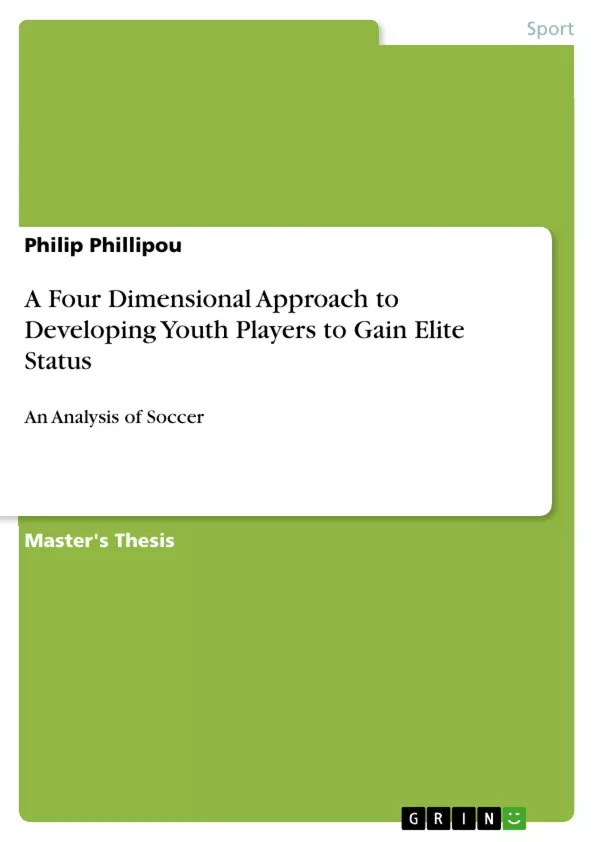This paper will demonstrate a long term athlete development programme based on a four dimensional approach (tactical, technical, physical and psycho-social). A one dimensional approach in isolation would be unrealistic and detrimental to football development. The modern game is rich in intensity, is multi-skilled, a contact sport and requires a quick thought-process. Therefore, a four dimensional approach will be used to combat these main pillars.
The information will be based upon a situation of an Academy Manager to develop elite players for the first team. The goal will be to develop at least 3 youth players for the first team every 2 seasons. The club which this paper is based on will follow the philosophy of developing players for the first team as opposed to a club that is willing to spend money on players who are already established or buying already talented young players from other clubs rather than developing their own.
Extensive research will be taken from books, academic papers, lectures, my own experiences and other reliable sources to gain maximal knowledge. Furthermore, each age group will be throughly discussed by analysing the potential benefits and fragilities of each age group, and also looking on how best to deal with these issues to obtain the maximal potential of each player. Finally, the curriculum advances in an age appropriate manner to show a clear progression through the age groups into adulthood.
Inhaltsverzeichnis (Table of Contents)
- Introduction
- The Four Dimensions
- Tactical
- Technical
- Physical
- Psycho-Social
- The Philosophy
- Playing Philosophy
- The Team
- The Player
- Physical
- Psycho-Social
- Coach Development and Expectations
- Staff Model
- Optimal Learning
- Style Contrasts
- Guided Discovery
- Coaches Feedback
- The Relative Age Effect & Maturation
- Growth & Maturation
- Adolescents
- Decision Making
- Tactical
- Technical
- Physical
- Psycho-Social
- Style
- Formation
- Positions
- Technical
- Repetition
- Physical
- Physical Requirements
- Stamina/Aerobic
- Speed and Sprints
- Agility
- Plyometrics
- Strength & Power
- Balance
- Anaerobic & Intensity
- Core
- Fundamental Movement Skills/Physical Literacy
- Burnout
- Injury Prevention
- Screening
- FIFA 11+
- Recovery
- Psycho-Social
- Growth Mindset
- Ignition
- Motivation
- Mental Skills
- Imagery
- Mental Toughness
- Confidence
- Self-Confidence & Self-Esteem
- Flow
- Goal Setting
- Short Term Goals
- Long Term Goals
- Character
- Character Traits
- The Role of the Parents
- Life Skills
- The Role of Education
- Practice
- Deliberate Practice
- The ‘Sweet Spot' (The Role of Myelin)
- Deliberate Play
- Rondos
- Tactical
- Technical
- Physical
- Psycho-Social
- Alternative Game Experience
- Futsal (Pre-Benjamin & Benjamin)
- Small Sided Games
- Syllabus
- Pre-Benjamin (7-8 year olds)
- Tactical
- Technical
- Physical
- Psycho-Social
- Benjamin (9-10 year olds)
- Tactical
- Technical
- Physical
- Psycho-Social
- Alevin (11-12 year olds)
- Tactical
- Technical
- Physical
- Psycho-Social
- Infantil (13-14 year olds)
- Tactical
- Technical
- Physical
- Psycho-Social
- Cadet (14-16 year olds)
- Tactical
- Technical
- Physical
- Psycho-Social
- Juvenile (16-18 year olds)
- Tactical
- Technical
- Physical
- Psycho-Social
- Looping
- Scouting, Talent ID & Assessments
- The importance of a holistic approach to youth player development
- The significance of the four dimensions in achieving elite status
- The role of coaching in fostering player growth and development
- The influence of mental skills and character traits on performance
- The impact of practice, deliberate play, and alternative game experiences on player development
Zielsetzung und Themenschwerpunkte (Objectives and Key Themes)
This thesis aims to provide a comprehensive approach to developing youth players in order to help them achieve elite status. It emphasizes a four-dimensional approach, encompassing tactical, technical, physical, and psycho-social aspects of player development.
Zusammenfassung der Kapitel (Chapter Summaries)
The Introduction outlines the four key dimensions of youth player development – tactical, technical, physical, and psycho-social – and introduces the philosophy behind the approach. It emphasizes the importance of a holistic approach to player development that encompasses all aspects of the game.
The chapter on Coach Development and Expectations discusses the role of coaches in fostering player growth. It explores key elements of coach development, including staff models, optimal learning strategies, and the importance of providing appropriate feedback. It also touches on the relative age effect and its impact on player maturation.
The chapter on Practice delves into the importance of deliberate practice and deliberate play in player development. It explores various methods and approaches to practice, including the use of rondos and alternative game experiences such as futsal and small-sided games. The chapter also emphasizes the importance of the “sweet spot” in player development, where practice and play intersect to optimize learning.
The chapter on Syllabus provides a detailed breakdown of the coaching syllabus for different age groups, from Pre-Benjamin (7-8 year olds) to Juvenile (16-18 year olds). It outlines the specific tactical, technical, physical, and psycho-social development objectives for each age group.
Schlüsselwörter (Keywords)
The key terms and concepts explored in this thesis include youth player development, elite status, tactical, technical, physical, psycho-social, coaching philosophy, staff models, optimal learning, deliberate practice, deliberate play, rondos, futsal, small-sided games, and scouting, talent ID, and assessments.
- Quote paper
- Philip Phillipou (Author), 2017, A Four Dimensional Approach to Developing Youth Players to Gain Elite Status, Munich, GRIN Verlag, https://www.grin.com/document/457828



